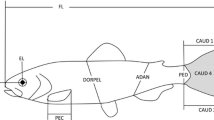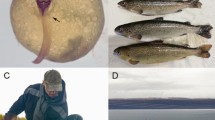Abstract
The environment mothers are exposed to has resonating effects on offspring performance. In iteroparous species, maternal exposure to stressors generally results in offspring ill-equipped for survival. Still, opportunities for future fecundity can offset low quality offspring. Little is known, however, as to how intergenerational effects of stress manifest in semelparous species with only a single breeding episode. Such mothers would suffer a total loss of fitness if offspring cannot survive past multiple life stages. We evaluated whether chronic exposure of female sockeye salmon (Oncorhynchus nerka) to a chase stressor impaired offspring performance traits. Egg size and early offspring survival were not influenced by maternal exposure to the repeated acute stressor. Later in development, fry reared from stressed mothers swam for shorter periods of time but possessed a superior capacity to re-initiate bouts of burst swimming. In contrast to iteroparous species, the mechanisms driving the observed effects do not appear to be related to cortisol, as egg hormone concentrations did not vary between stressed and undisturbed mothers. Sockeye salmon appear to possess buffering strategies that protect offspring from deleterious effects of maternal stress that would otherwise compromise progeny during highly vulnerable stages of development. Whether stressed sockeye salmon mothers endow offspring with traits that are matched or mismatched for survival in the unpredictable environment they encountered is discussed. This study highlights the importance of examining intergenerational effects among species-specific reproductive strategies, and across offspring life history to fully determine the scope of impact of maternal stress.

Similar content being viewed by others
References
Badyaev AV, Uller T (2009) Parental effects in ecology and evolution: mechanisms, processes and implications. Philos Trans R Soc Lond B 364:1169–1177
Benediktsson R, Calder AA, Edwards CRW, Seckl JR (1997) Placental 11β-hydroxysteroid dehydrogenase: a key regulator of fetal glucocorticoid exposure. Clin Endocrinol 46:161–166
Bradford MJ (1995) Comparative review of Pacific salmon survival rates. Can J Fish Aquat Sci 52:1327–1338
Braun DC, Patterson DA, Reynolds JD (2013) Maternal and environmental influences on egg size and juvenile life-history traits in Pacific salmon. Ecol Evol 3:1727–1740
Breuner C (2008) Maternal stress, glucocorticoids, and the maternal/fetal match hypothesis. Horm Behav 54:485–487
Brooks S, Tyler CR, Sumpter JP (1997) Egg quality in fish: what makes a good egg? Rev Fish Biol Fish 7:387–416
Burt JM, Hinch SG, Patterson DA (2012) Developmental temperature stress and parental identity shape offspring burst swimming performance in sockeye salmon (Oncorhynchus nerka). Ecol Freshw Fish 21:176–188
Burton T, Hoogenboom MO, Armstrong JD, Groothuis TGG, Metcalfe NB (2011) Egg hormones in a highly fecund vertebrate: do they influence offspring social structure in competitive conditions? Funct Ecol 25:1379–1388
Campbell PM, Pottinger TG, Sumpter JP (1994) Preliminary evidence that chronic confinement stress reduces the quality of gametes produced by brown and rainbow trout. Aquaculture 120:151–169
Cohen BI (2012) Commission of Inquiry into the Decline of Sockeye Salmon in the Fraser River. Public Works and Government Services Canada, Ottawa. Cat. No.: CP32-93/2012E−1 (v. 1)
Cook KV, McConnachie SH, Gilmour KM, Hinch SG, Cooke SJ (2011) Fitness and behavioral correlates of pre-stress and stress-induced plasma cortisol titers in pink salmon (Oncorhynchus gorbuscha) upon arrival at spawning grounds. Horm Behav 60:489–497
Coslovsky M, Richner H (2011) Predation risk affects offspring growth via maternal effects. Funct Ecol 25:878–888
Dickens MJ, Romero LM (2013) A consensus endocrine profile for chronically stressed wild animals does not exist. Gen Comp Endocrinol 191:177–189
Donaldson MR (2012) Understanding the consequences of fisheries-related stressors on adult migrating Pacific salmon. PhD dissertation, University of British Columbia, Vancouver
Eriksen MS, Færevik G, Kittilsen S, McCormick MI, Damsgård B, Braithwaite VA, Braastad BO, Bakken M (2011) Stressed mothers-trouble offspring: a study of behavioural maternal effects in farmed Salmo salar. J Fish Biol 79:575–586
Groot C, Margolis L (1991) Pacific salmon life histories. University of British Columbia Press, Vancouver
Heath DD, Blouw DM (1998) Are maternal effects in fish adaptive or merely physiological side effects? In: Mousseau TA, Fox CW (eds) Maternal effects as adaptations. Oxford University Press, New York, pp 178–201
Henriksen R, Rettenbacher S, Groothuis TGG (2011) Prenatal stress in birds: pathways, effects, function and perspectives. Neurosci Biobehav Rev 35:1484–1501
Jeffries KM, Hinch SG, Sierocinski T, Clark TD, Eliason EJ, Donaldson MR, Li S, Pavlidis P, Miller KM (2012) Consequences of high temperatures and premature mortality on the transcriptome and blood physiology of wild adult sockeye salmon (Oncorhynchus nerka). Ecol Evol 2:1747–1764
Johnsson B (1997) A review of ecological and behavioural interactions between cultured and wild Atlantic salmon. ICES J Mar Sci 54:1031–1039
Li M, Christie HL, Leatherland JF (2012) The in vitro metabolism of cortisol by ovarian follicles of rainbow trout (Oncorhynchus mykiss): comparisons with ovulated oocytes and pre-hatch embryos. Reproduction 144:713–722
Love OP, Williams TD (2008) The adaptive value of stress-induced phenotypes in the wild: effects of maternally-derived corticosterone on sex allocation, cost of reproduction and maternal fitness. Am Nat 172:E135–E149
Love OP, McGowan OP, Sheriff MJ (2013) Maternal adversity and ecological stressors in natural populations: the role of stress axis programming in individuals, with implications for populations and communities. Funct Ecol 27:81–92
Maldonado TA, Jones RE, Norris DO (2002) Timing of neurodegeneration of beta-amyloid (AB) peptide deposition in the brain of aging kokanee salmon. Dev Neurobiol 53:21–35
McConnachie SH, Cook KV, Patterson DA, Gilmour KM, Hinch SG, Farrell AP, Cooke SJ (2012) Consequences of acute stress and cortisol manipulation on the physiology, behavior, and reproductive outcome of female Pacific salmon on spawning grounds. Horm Behav 62:67–76
McGhee KE, Pintor LM, Suhr EL, Bell AM (2012) Maternal exposure to predation risk decreases offspring antipredator behaviour and survival in threespined stickleback. Funct Ecol 26:932–940
Mingist M, Kitani T, Koide N, Ueda H (2007) Relationship between eyed-egg percentage and levels of cortisol and thyroid hormone in masu salmon Oncorhynchus masou. J Fish Biol 70:1045–1056
Mommsen TP, Vijayan MM, Moon TW (1999) Cortisol in teleosts: dynamics, mechanisms of action, and metabolic regulation. Rev Fish Biol Fish 9:211–268
Mousseau TA, Fox CW (1998) The adaptive significance of maternal effects. Trends Ecol Evol 13:403–407
Patterson DA, Guderley H, Bouchard P, Macdonald JS, Farrell AP (2004) Maternal influence and population differences in activities of mitochondrial and glycolytic enzymes in emergent sockeye salmon (Oncorhynchus nerka) fry. Can J Fish Aquat Sci 61:1225–1234
Räsänen K, Kruuk LEB (2007) Maternal effects and evolution at ecological time-scales. Funct Ecol 21:408–421
Roche DP, McGhee KE, Bell AM (2012) Maternal predator-exposure has lifelong consequences for offspring learning in threespined sticklebacks. Biol Lett 8:932–935
Romero LM (2004) Physiological stress in ecology: lessons from biomedical research. Trends Ecol Evol 19:249–255
Schreck CB, Contreras-Sanchez W, Fitzpatrick MS (2001) Effects of stress on fish reproduction, gamete quality, and progeny. Aquaculture 197:3–24
Sheriff MJ, Love OP (2013) Determining the adaptive potential of maternal stress. Ecol Lett 16:271–280
Sloman KA (2010) Exposure of ova to cortisol pre-fertilisation affects subsequent behaviour and physiology of brown trout. Horm Behav 58:433–439
Sopinka NM, Hinch SG, Lotto AG, Whitney CK, Patterson DA (2013) Does among-population variation in burst swim performance of sockeye salmon Oncorhynchus nerka fry reflect early life migrations? J Fish Biol 83:1416–1424
Stratholt ML, Donaldson EM, Liley NR (1997) Stress induced elevation of plasma cortisol in adult female coho salmon (Oncorhynchus kisutch), is reflected in egg cortisol contest, but does not appear to affect early development. Aquaculture 158:141–153
Taylor EB, McPhail JD (1985) Burst swimming and size-related predation of newly emerged coho salmon Oncorhynchus kisutch. Trans Am Fish Soc 114:546–551
Whitney CK, Hinch SG, Patterson DA (2013) Provenance matters: thermal reaction norms for embryo survival among sockeye salmon Oncorhynchus nerka populations. J Fish Biol 82:1159–1176
Wingfield JC, Sapolsky RM (2003) Reproduction and resistance to stress: when and how. J Neuroendocrinol 15:711–724
Acknowledgments
All research conformed to protocols approved by the University of British Columbia Committee on Animal Care (#A11 0215) and met the Canadian Council for Animal Care guidelines. We thank members of UBC’s Pacific Salmon Ecology and Conservation Laboratory, Chehalis First Nation, DFO Cultus Lake Salmon Research Laboratory, DFO Environmental Watch, and undergraduate volunteers for fish collection and offspring rearing, and G. Raby, two anonymous reviewers and Marc Mangel for helpful manuscript comments. S.G.H. is funded by a Natural Sciences and Engineering Research Council (NSERC) Discovery and Strategic grant, and the Ocean Tracking Network. N.M.S. was funded by an NSERC graduate scholarship, and C.T.M. was funded by an NSERC undergraduate student research award (USRA).
Author information
Authors and Affiliations
Corresponding author
Additional information
Communicated by Marc Mangel.
Rights and permissions
About this article
Cite this article
Sopinka, N.M., Hinch, S.G., Middleton, C.T. et al. Mother knows best, even when stressed? Effects of maternal exposure to a stressor on offspring performance at different life stages in a wild semelparous fish. Oecologia 175, 493–500 (2014). https://doi.org/10.1007/s00442-014-2915-9
Received:
Accepted:
Published:
Issue Date:
DOI: https://doi.org/10.1007/s00442-014-2915-9




